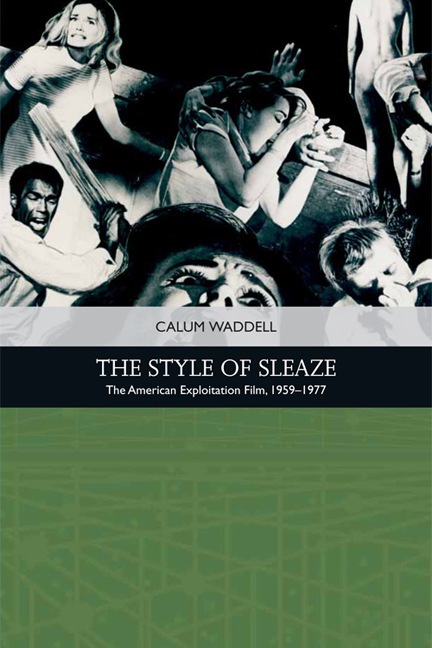Book contents
- Frontmatter
- Contents
- List of Figures
- Acknowledgements
- Introduction
- 1 Not Quite Hollywood
- 2 Emerging from Another Era – Narrative and Style in Modern Exploitation Cinema
- 3 Can We Call It Sexploitation?
- 4 Sex Morality Plays: Character in Adult Cinema
- 5 The Body is Everything: Sexploitation Spectacle
- 6 Exploitation-Horror Cinema
- 7 Cannibalising Tradition: Romero’s Zombies and a Blood Feast
- 8 Slash and Burn: The Exploitation-Horror Film in Transition
- 9 Blaxploitation Cinema: Race and Rebellion
- 10 Sex, Violence and Urban Escape: Blaxploitation Tropes and Tales
- 11 The Blaxploitation Female
- 12 Exploitation as a Movement
- Select Bibliography
- Index
3 - Can We Call It Sexploitation?
Published online by Cambridge University Press: 11 November 2020
- Frontmatter
- Contents
- List of Figures
- Acknowledgements
- Introduction
- 1 Not Quite Hollywood
- 2 Emerging from Another Era – Narrative and Style in Modern Exploitation Cinema
- 3 Can We Call It Sexploitation?
- 4 Sex Morality Plays: Character in Adult Cinema
- 5 The Body is Everything: Sexploitation Spectacle
- 6 Exploitation-Horror Cinema
- 7 Cannibalising Tradition: Romero’s Zombies and a Blood Feast
- 8 Slash and Burn: The Exploitation-Horror Film in Transition
- 9 Blaxploitation Cinema: Race and Rebellion
- 10 Sex, Violence and Urban Escape: Blaxploitation Tropes and Tales
- 11 The Blaxploitation Female
- 12 Exploitation as a Movement
- Select Bibliography
- Index
Summary
Unlike most other studies that discuss the ‘sexploitation’ era I have chosen not to separate the trend in softcore films (that is, simulated depictions of sex) from the later boom in hardcore cinema (unsimulated). While I accept that the popularity and prominence of unsimulated sex films did indicate, to quote Church, ‘a gradual move from excessive fantasies to permissive realities’, I think that the stylistic similarities between the two periods is more profound than many have asserted or discussed. Moreover, it is difficult to draw a line with the appearance of hardcore and conclude that, just like that, it eliminated the softcore sex film from theatres. Indeed, only a few years after the accepted trendsetting ‘porno chic’ classic Deep Throat (Gerard Damiano, 1972) audiences were flocking to see – not explicit depictions of oral and vaginal sex – but rather R-rated nudity and simulated intercourse in films such as Porky's (Bob Clark, 1981). In 1986 Adrian Lyne's 9½ Weeks was the new cause célèbre despite being visually tame. As such, the rise and fall of sexploitation – at least within the exploitation movement – requires answers: why is it, for instance, that today audiences flock to 50 Shades of Grey (Sam Taylor-Johnson, 2015) but not unsimulated sex spectacles? It was the ‘excessive fantasies’ that audiences ultimately warmed to rather than the hardcore realities of bodily fluids, erections and penetration. In other words: the sexploitation style – from soft to hard – faded from commercial prominence after the audience got to see everything. As such, the style of filmmaking that graduated sexploitation from simulations to the ‘real thing’ was, ultimately, unable to evolve beyond a brave new world of Hollywoodised gloss, home-video cheapness and an ever-decreasing notoriety.
A tension exists between a so-called lowbrow and highbrow approach to marginal cinema (with Arthur Knight arguing that the only difference between art and exploitation screenings is ‘the demitasse of black coffee in the lobby of the snootier establishments’). Indeed, there is a general understanding that hardcore exists as a different kind of exploitation cinema – Gorfinkel, for instance, is careful to separate the softcore films of Radley Metzger from his later, more sexually explicit, work.
- Type
- Chapter
- Information
- The Style of SleazeThe American Exploitation Film, 1959–</I>1977, pp. 47 - 63Publisher: Edinburgh University PressPrint publication year: 2018



